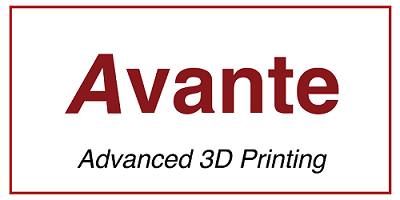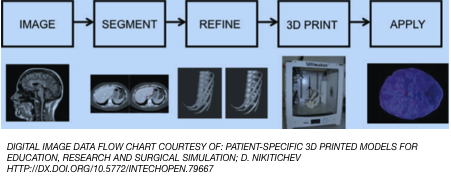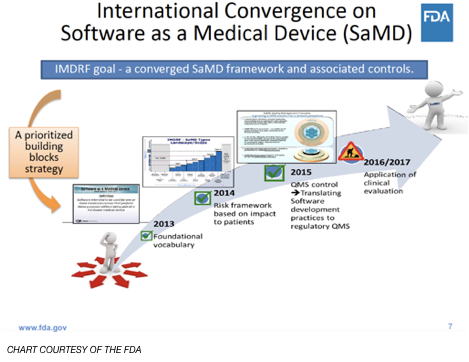
In 2019, the FDA, in collaboration with its peer regulatory organizations in the industrialized world through the IMDRF program, adopted a new definition of “Software as a Medical Device” (SaMD) to be used in evaluating new medical devices. This revised definition includes much of the software tool chain used to scan/create, segment and prepare radiologic 3D image files for additive manufacturing of medical devices.

New software medical devices submitted to the FDA for certification must meet stringent quality management system(“QMS”) requirements. Central to demonstrating, validating and maintaining an FDA approved QMS, software vendors must demonstrate their claimed level of accuracy, precision and reliability throughout the image capture-design-to-production process before and after certification. An FDA specified third party audit will attempt to validate such claims to ensure reliable operation in the field.

Recording and transmitting accuracy and precision data through the “scan-to-segment-to- print” process has been problematic, as this information is not standardized. Moreover, there is no support for integrating such information within STL and OBJ 3D file formats commonly in use today. Key patient and precision information runs the risk of being lost, mis-interpreted or applied to the wrong 3D file’s print job.
In 2016, The International Standards Organization(ISO) teamed up with ASTM to publish an updated version of the Additive Manufacturing Format (“AMF”) to address the expanding needs of additive manufacturing in a wider range of industries, including medical device manufacturing. This standard was published as ASTM/ISO 52915: 2016 and is being supported by a joint technical working group consisting of members of both standards organizations. Although this format was recommended by the FDA in its published guidance on 3D printing of medical devices, few medical device manufacturers have adopted it to date.
This ISO standard format has the potential to help software vendors address the new FDA requirements by including the accuracy and precision profiles for software tools used throughout the entire scan-to-print process within the image file in a standardized, easy to read manner. FDA required labeling information and other pertinent patient, quality and security meta data could also be easily integrated within the XML based AMF file in a standardized way.
There are 5 key attributes of AMF that make this format the right format for medical device manufacturing today and in the future:
- AMF is extensible: This XML based format allows for adding meta- data to meet application specific requirements. For example, version history of each software application used and the stated precision of that application’s output could be listed in XML. The source, author and published accuracy of radiologic scans could be easily listed as well. FDA labeling information could also be added in text form. All key information would be safely encapsulated within a singe file, providing a digital file history log that could be used to verify the accuracy and precision of the image file, providing essential information for each manufacturer in the process to include in their quality management systems.
- ISO/ASTM AMF is an open, royalty free international standard format. AMF is the only international standard for 3D files used in additive manufacturing. It is endorsed by NIST, America Makes, and is being actively maintained by the ISO/ASTM joint technical committee TC261 to ensure it supports new additive manufacturing technologies and applications as the need arises. There is a working group within TC261 investigating ways to improve support for medical imaging applications. Standardizing the format of key meta-data in XML as described in this article could be added to a future version of AMF, but there is no legal or licensing obstacle for medical device manufacturers to create a common method for writing relevant meta data to an AMF file for use within the medical industry now.
- Unlike the commonly used STL format, AMF supports multiple colors in a single 3D file, at object level, component level or facet level of the 3D mesh, allowing for greater accuracy.

- AMF supports multiple materials in a single 3D file, at object level or component level of the file, providing for more realistic and/or practical results.
- AMF supports multi object “constellations” in a single 3D file. This capability provides for sets of objects to precisely located in specified positions relative to each other. This also enables printing multiple intertwined parts made from different materials and/or colors. An example of where this is useful is printing a prosthetic hand assembly that includes interlocking parts, some stiff and some flexible.
Summary: Software developers and additive manufacturers face a challenge in meeting new FDA quality management system requirements for software medical devices. The lack of standardized methods of handling key meta data through the scan-segmentation-refinement-print process can be easily addressed by adoption of the ASTM/ISO AMF 3D file format. Vendors in the additive manufacturing ecosystem can agree on a common method of defining precision, version history, FDA labeling and patient data in XML and add this to the extensible AMF format to create a safe, standardized and reliable means of transmitting all mission critical file data through each step of the process.
Compared with other methods, using AMF files as the standard container for all key file data is a relatively low cost to and safe approach to meeting the new FDA quality management requirements.
For more information on this topic, the author will be speaking on this subject at the Additive Manufacturing Strategies conference being held February 11–12, 2020 in Boston. Information on the conference is available here.
You can contact the author directly via email at: bobz (at) avante-technology.com
——
About the author:
Robert Zollo is Founder and President of Avante Technology, LLC an applied research company that develops advanced software and design for additive manufacturing processes to improve product quality. He is a member of the ASTM F42 committee on additive manufacturing and the DICOM WG-17 committee on additive manufacturing for medical imaging. As former Chairman of the Optical Storage Technology Association, Mr. Zollo managed the development of the Universal Disc Format(“UDF”) file format used on all DVD, Blu-ray and most other optical recording discs, including DICOM format optical media. UDF is the basis for the ISO 13346 international standard for optical recording formats.
Copyright Robert Zollo 2020.
Subscribe to Our Email Newsletter
Stay up-to-date on all the latest news from the 3D printing industry and receive information and offers from third party vendors.
You May Also Like
3D Printing Unpeeled: New Arkema Material for HP, Saddle and Macro MEMS
A new Arkema material for MJF is said to reduce costs per part by up to 25% and have an 85% reusability ratio. HP 3D HR PA 12 S has been...
3D Printing News Briefs, January 20, 2024: FDM, LPBF, Underwater 3D Printer, Racing, & More
We’re starting off with a process certification in today’s 3D Printing News Briefs, and then moving on to research about solute trapping, laser powder bed fusion, and then moving on...
3D Printing Webinar and Event Roundup: December 3, 2023
We’ve got plenty of events and webinars coming up for you this week! Quickparts is having a Manufacturing Roadshow, America Makes is holding a Member Town Hall, Stratafest makes two...
Formnext 2023 Day Three: Slam Dunk
I’m high—high on trade show. I’ve met numerous new faces and reconnected with old friends, creating an absolutely wonderful atmosphere. The excitement is palpable over several emerging developments. The high...































